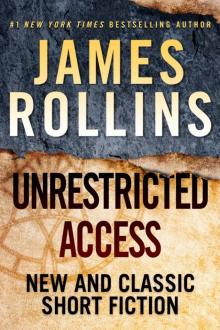- Home
- James Rollins
Sigma Guide Page 7
Sigma Guide Read online
Page 7
Also in pursuit of the forbidden secrets is Rafael Saint Germaine, a French aristocrat and high-ranking Guild operative. Rafe and his mercenaries pursue Painter, Kai, and the others from Utah to Arizona, where long-buried ruins suggest that the Anasazi, a prehistoric Native American culture, may have stolen the secrets of the Tawtsee’unsaw Pootseev —and been destroyed as a result.
Meanwhile, Gray Pierce, Monk Kokkalis and Seichan follow an historical trail blazed by legendary explorer Meriwether Lewis (of “Lewis and Clark” fame) and Archard Fortescue, an eighteenth-century French scientist who secretly joined Lewis on some of his travels. Both men, it appears, were working on behalf of Thomas Jefferson to protect the secrets of the Tawtsee’unsaw Pootseev from an insidious “Enemy”—who might very well have been the Guild. These secrets are linked to Jefferson’s unrealized plans to create a Fourteenth Colony for America’s Indian population, located around the lost city of the Tawtsee’unsaw Pootseev. Gray and his team clash with the Guild as they retrace Fortescue’s travels from a volcanic island off the coast of Iceland, where a cataclysmic [REDACTED] nearly kills them, to the United States Bullion Depository at Fort Knox, where they find a golden map hidden by Jefferson centuries ago. The map points Sigma toward Yellowstone National Park, even as Gray and his team search for more clues by unearthing the grave of Meriwether Lewis—who may have been assassinated by the Guild back as 1809.
To make matters worse, scientists at the Kamioka Observatory in Japan detect a sudden spike in neutrinos emanating from the violated cave in Rockies. The Utah event triggers neutrino bursts at other sites around the world, including Iceland and Yellowstone, setting off a chain reaction that will ultimately cause a [REDACTED] that could wipe out humanity once and for all. With time running out, Sigma Force must join into an uneasy alliance with the Guild to find “the Devil Colony” before the end of the world arrives just as foretold . . . .
Assessment:
Several Sigma agents have a personal stake this time around. Painter forms a connection with his “niece.” Monk and Kat survive to see the birth of their second daughter, Harriet, an event which causes Monk to rethink his future with Sigma Force. Gray suffers a devastating personal loss, which ultimately brings him closer to Seichan . . . at least for the moment.
Turning to the bigger picture, a fuller picture of the Guild continues to emerge. Rafe, who belongs to the upper Echelon, eventually reveals that the shadowy organization is now led by a single ancient family, “the True Bloodline,” stretching back millennia. To stay strong, this ancient clan absorbs younger families of the Echelon, according to a three-tier ranking system. A distinctive tattoo, which hints at connections to both the Freemasons and the Knights Templar, indicates a member’s rank in the Echelon. These powerful clans have also been known as “the star families” (famillles de l’etoile). According to Rafe, the Guild is “the secret within all secret societies.”
And that secret is bound up with the birth of America. Historical evidence unearthed by Gray and Seichan suggest that the True Bloodline flowed through the original thirteen colonies from the beginning, with a certain prominent family so entrenched in the slave trade that any attempt to wrest them out would have ripped the fledgling nation apart. This was the “Enemy” Jefferson fought against centuries ago, and who, Painter deduces, now goes by the name of [REDACTED].
The true origins of Tawtsee’unsaw Pootseev remain murky, but evidence suggests that they were descended from an ancient order of shamans and magi dating back to ancient Egypt, not unlike the lost magi Sigma investigated a few years ago [MOB]. Are these the same magi as before? The evidence, particularly the Egyptian connection, is provocative, but no definite conclusions can be reached at this time.
Σ
The enigmatic death of a great explorer.
Meriwether Lewis (1774-1809) helped open up the American West, but died under mysterious circumstances only three years later. In 1803, on behalf of President Thomas Jefferson, Lewis and his fellow Virginian, William Clark, led a historic transcontinental expedition from Illinois to the Pacific coast. The Lewis and Clark Expedition provided a wealth of information on the continent’s flora, fauna, geography, and Native American peoples. The journey, including the return trip, took two years, four months, and ten days.
For his efforts, Lewis was appointed governor of the Louisiana Territory, but his administration was a troubled one, plagued by political rivals and budgetary disputes. In 1809, while en route to Washington D.C., Lewis paused for the night at a Grinder’s Stand, an inn along a rugged pioneer trail in what is now the state of Tennessee. Shots rang out in the night and Lewis was found with gunshot wounds to the head and side. He died atop a bloody buffalo robe at the age of thirty-five. (More than two centuries later, that same buffalo hide would play a key role in Sigma’s search for the Devil Colony.)
Controversy surrounds his death to this day. Jefferson and Clark, along with many historians, believed that a despondent Lewis took his own life, while others, including a doctor who examined the body in 1848, believed that he had been murdered for reasons unknown. Sigma’s own investigation suggests that Lewis may have been killed by an agent of the Guild because [REDACTED].
Lewis is buried beneath a monument in the Natchez Trace Parkway, not far from where he died. Efforts to have the body exhumed in hopes of determining the truth behind his death have been rejected by the National Park Service.
Not that this stopped Gray Pierce.
Σ
Who were the Anasazi—and what became of them?
The prehistoric Native American people we call the Anasazi once inhabited what is now the Four Corners region of the American Southwest, where Utah, Arizona, New Mexico, and Colorado meet. “Anasazi” is a Navajo word which can mean either “Ancient Ones” or “Ancient Enemy.” The name was adopted by modern archaeologists in 1927, but some Pueblo Indians now prefer the terms “Ancient Pueblo People” or “Ancestral Pueblo.” It is unknown what the Anasazi called themselves since even their language or languages have been lost to history.
The Anasazi, who hit their height between 900 and 1300 AD, centuries before Columbus, are best known for their monumental cliff-dwellings—and for the way they abruptly abandoned their settlements, leaving behind imposing ruins at such locations as Chaco Canyon, New Mexico and Mesa Verde, Colorado. They often left behind their possessions as well, including fine pottery and basketry. By the time, the Spanish arrived in the 1500s, the ruins stood empty and the Navajo had inherited the land once occupied by the “Ancient Enemy.”
Why exactly the Anasazi “vanished” remains unclear, although it is theorized that climate change and endless droughts drove the Anasazi to disperse to more hospitable climes. There is also evidence of violence, warfare, religious upheaval, and perhaps even cannibalism. Many modern-day Pueblo Indians, such as the Hopi and the Zuni, list the Anasazi among their ancestors.
But was there another reason the Anasazi fled their homes and lands, never to return? Sigma’s own investigation revealed that the Anasazi brought about their doom by [REDACTED].
Σ
Building from the bottom up.
A nanometer is one-billionth of a meter, roughly 100,000 times smaller than the diameter of a human hair. Nanotechnology, loosely speaking, involves engineering and manufacturing on the atomic and molecular level. It is a (supposedly) new technology that holds tremendous promise for the future, as well as potential hazards.
On the positive side, nanotech is opening up new horizons in manufacturing techniques, medicine, information technology, energy production, and other fields. Nanoscale materials, such as carbon nanotubes only one nanometer in diameter, are already employed to make products such as baseball bats and motorcycle helmets stronger, lighter, and more durable. Cheaper and more efficient solar panels, incorporating nanotech, are already in the works. Medical researchers are looking into ways to use nanotech to repair damaged spinal cords. Down the road, home fabricators may allow you to build almost any
product in your own home, one molecule at a time.
New and unexpected applications for nanotech are being found all the time. For example, European scientists recently employed nanotech to detect blood cells in a 5,300 year old glacier mummy. These are the oldest traces of human blood to be found anywhere in the world. (Something bound to be of interest to Sigma Force.)
On the other hand, nanotech is not without its dangers. The toxicity of carbon nanotubes and other such materials is already a cause for concern, while, in theory, nanotech could also be employed to creates frightening new weapons and means of surveillance. There is also the potential for environmental disasters. The worst-case scenario: swarms of out-of-control, self-replicating micro-machines dissembling everything they come in contact with, including the planet itself. This is seen as a remote possibility, but not (as Sigma Force discovered) an impossible one.
Nanotechnology is a boom industry. In 2000, the U.S. Government launched the National Nanotechnology Initiative (NNI) to expedite “the discovery, development and deployment of nanoscale science and technology to serve the public good, through a program of coordinated research and development.” DARPA is among the many federal agencies taking part in NNI, which has is slated to receive $1.8 billion in government funding in 2013. Similar initiatives have been launched by nations throughout the world, including Europe and Asia.
For more information, check out: http://nano.gov.
Nanotech is believed to be a modern development, but this may not be entirely the case. Saber blades made of “Damascus steel,” a type of steel employed from the 13th to 18th centuries, have been found to contain carbon nanotubes—which may explain their legendary reputation for strength and sharpness. The exact process by which Damascus steel was forged was lost centuries ago, long before modern nanotech was invented—or perhaps reinvented.
Mission Designation: Bloodline
Duration: June 30-July 12. A month after TDC.
Key Locations: USA, Somalia, Dubai, Zanzibar.
When a pregnant American woman is kidnapped by Somalian pirates, Sigma Force is called into action. A rescue mission does not usually fall under Sigma’s purview, but this abduction is different—because the hostage is the President’s daughter.
[The details of this operation remain classified.]
FACING THE FUTURE
Sigma Force has endured many changes since Painter Crowe was first recruited as an agent. There have been changes in leadership, changes in personnel, and dramatic changes in the lives of the extraordinary men and women who serve in secret to protect America and the world from scientific mysteries and marvels both new and very, very old. Sigma’s political fortunes have risen and fallen, and a relentless enemy has gradually emerged from the shadows in the form of the Guild, but Sigma’s mission remains the same: to get there first—before the bad guys do.

 The Skeleton Key
The Skeleton Key The Last Oracle
The Last Oracle The Judas Strain
The Judas Strain Black Order
Black Order Sandstorm
Sandstorm Ghost Ship
Ghost Ship The Devil Colony
The Devil Colony Subterranean
Subterranean The Doomsday Key
The Doomsday Key The 6th Extinction
The 6th Extinction Bloodline
Bloodline Jake Ransom and the Howling Sphinx
Jake Ransom and the Howling Sphinx The Midnight Watch
The Midnight Watch Map of Bones
Map of Bones The Demon Crown
The Demon Crown Deep Fathom
Deep Fathom Sigma Guide
Sigma Guide Kowalski's in Love
Kowalski's in Love Jake Ransom and the Skull King's Shadow
Jake Ransom and the Skull King's Shadow Excavation
Excavation The Seventh Plague
The Seventh Plague Altar of Eden
Altar of Eden Unrestricted Access: New and Classic Short Fiction
Unrestricted Access: New and Classic Short Fiction Indiana Jones and the Kingdom of the Crystal Skull
Indiana Jones and the Kingdom of the Crystal Skull Crucible
Crucible The Eye of God
The Eye of God The Bone Labyrinth
The Bone Labyrinth The Last Odyssey: A Thriller
The Last Odyssey: A Thriller Unrestricted Access
Unrestricted Access Amazonia
Amazonia Blood Brothers: A Short Story Exclusive
Blood Brothers: A Short Story Exclusive Map of Bones: A Sigma Force Novel
Map of Bones: A Sigma Force Novel The Skeleton Key (sigma force)
The Skeleton Key (sigma force) Sigma Force 10 - The Sixth Extinction
Sigma Force 10 - The Sixth Extinction Innocent Blood
Innocent Blood Map of Bones sf-2
Map of Bones sf-2 The Eye of God: A Sigma Force Novel
The Eye of God: A Sigma Force Novel The Eye of God: A Sigma Force Novel sf-9
The Eye of God: A Sigma Force Novel sf-9 The Pit
The Pit Indiana Jones and the The Kingdom Of The Crystal Skull
Indiana Jones and the The Kingdom Of The Crystal Skull The Last Oracle (2008) sf-5
The Last Oracle (2008) sf-5 City of Screams
City of Screams The Doomsday Key and The Last Oracle with Bonus Excerpts
The Doomsday Key and The Last Oracle with Bonus Excerpts The Judas Strain sf-4
The Judas Strain sf-4 Blood Infernal
Blood Infernal The Demon Crown: A Sigma Force Novel
The Demon Crown: A Sigma Force Novel War Hawk: A Tucker Wayne Novel
War Hawk: A Tucker Wayne Novel SANDSTORM sf-1
SANDSTORM sf-1 Bloodline: A Sigma Force Novel
Bloodline: A Sigma Force Novel Amazonia: a novel
Amazonia: a novel The Last Oracle: A Sigma Force Novel
The Last Oracle: A Sigma Force Novel City of Screams (the order of the sanguines)
City of Screams (the order of the sanguines) Ghost Ship: A Sigma Force Short Story
Ghost Ship: A Sigma Force Short Story The Doomsday Key: A Sigma Force Novel
The Doomsday Key: A Sigma Force Novel